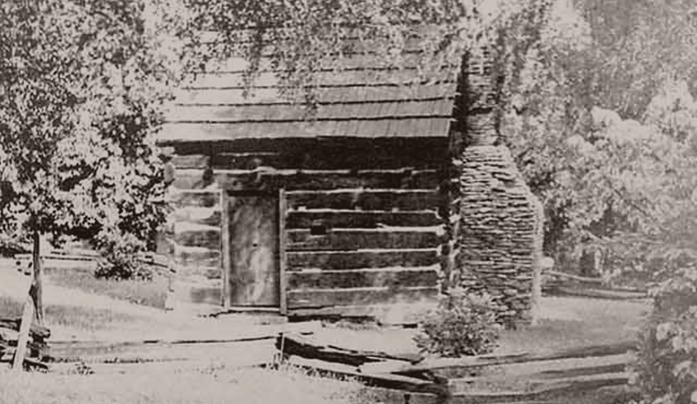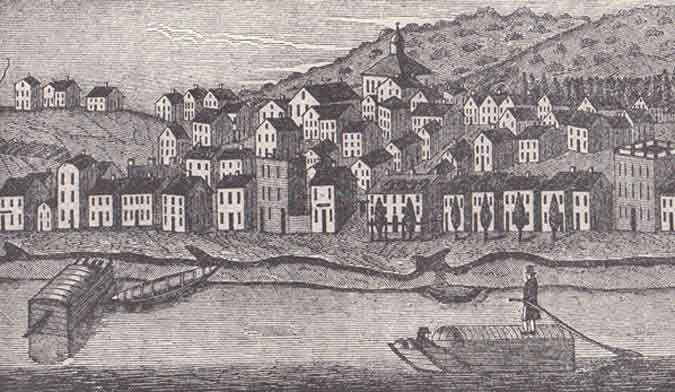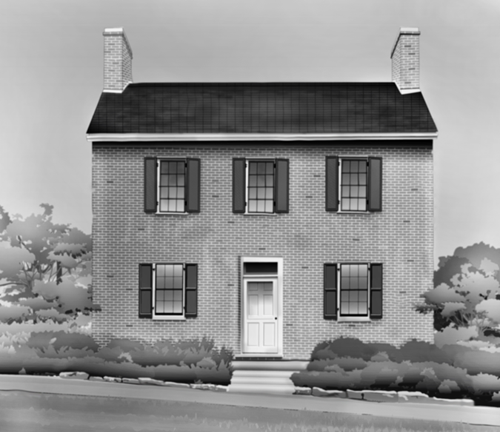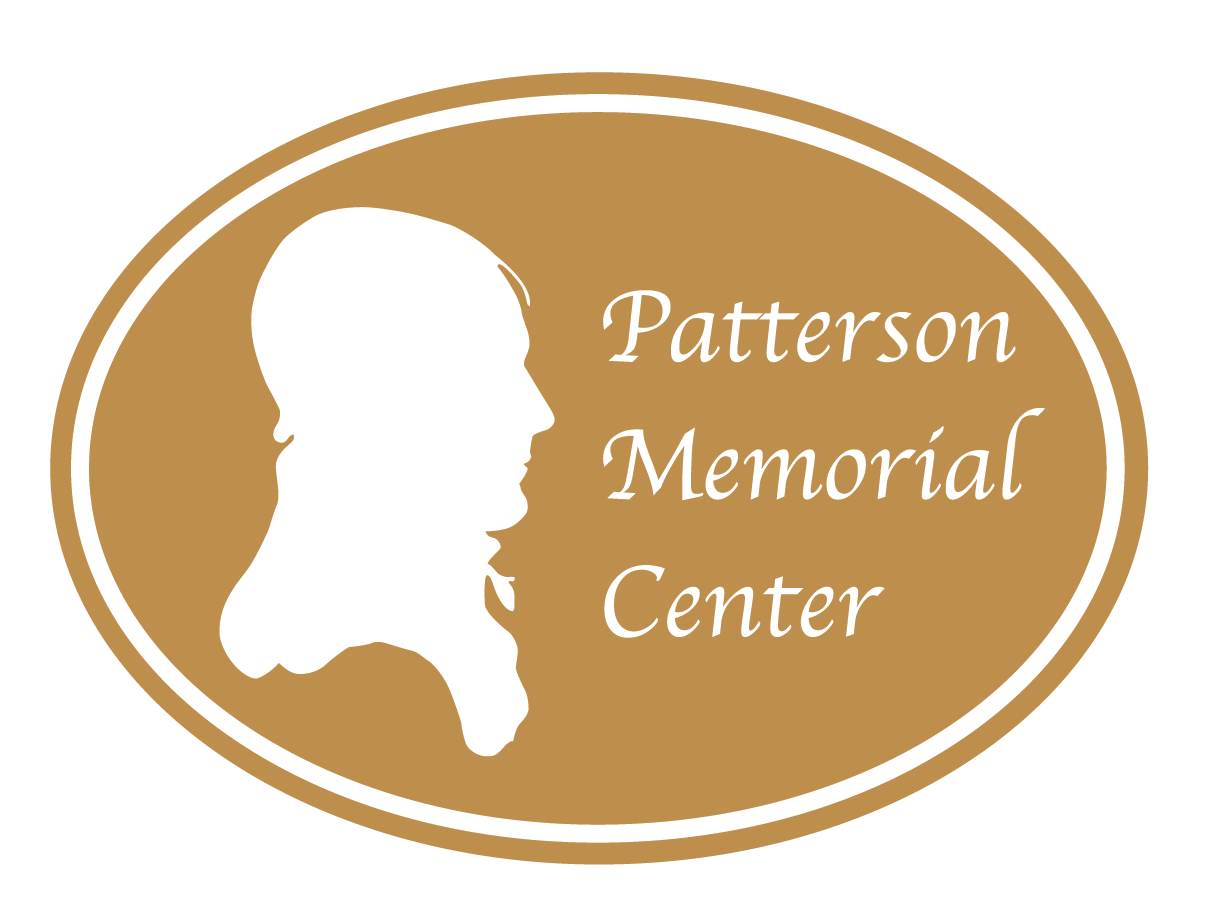
Robert Patterson was born on March 23, 1753, in Cumberland (now Bedford) County, Pennsylvania, to Francis and Jane Patterson; his parents were descended from Scotch-Irish immigrants.
Following the westward migration of colonial Americans over the Appalachian Mountains and down the Ohio River, Robert moved to the Kentucky Territory in 1775. He claimed land for his father; brother, William; and himself; and built a small cabin. That site would eventually become the City of Lexington.
LINK TO ENDNOTE: How did settlers claim land?

At the beginning of the war, Robert joined the militia and fought many battles with the Native Americans in the Ohio Country as the British incited most of the tribes to fight against the Americans. The Native Americans frequently staged raids into the Kentucky Territory. The British promised the Native Americans that they would retain their lands in exchange for helping them.
LINK TO ENDNOTE: What tribes in Ohio fought for the British?
While recovering from wounds after a Native-American attack in October 1776, Robert spent several months at Fort Pitt (present day Pittsburgh) before returning home to recover.
LINK TO ENDNOTE: How did Robert find himself in a Native-American attack?
In spring 1777, Robert visited relatives and neighbors as he recovered, including the Lindsay family. He and Elizabeth Lindsay became engaged.
Robert and Elizabeth were separated for three years because of the war. However, on March 29, 1780, Robert and Elizabeth were married in the Lindsay home in Falling Springs (now Chambersburg), Pennsylvania. Then, they made the long, hazardous trip over the Appalachian Mountains and down the Ohio River to his primitive, one-room cabin in the Kentucky wilderness.
LINK TO ENDNOTE: Read about the wedding!
Robert continued to serve in the militia, mainly fighting Native Americans. His most famous battle was the Battle of Blue Licks.
On August 15, 1782, British Rangers, and Wyandot and other Native Americans from the Great Lakes region, laid siege to Bryant's Station in the Kentucky Territory. The next day, Robert led the Lexington militia to Bryant's Station and repelled the siege.
Within a few days, militiamen from all over the Kentucky Territory, including Daniel Boone, arrived at Bryant's Station. A decision was made to pursue the British and Native Americans with a battle erupting near the Licking River on August 19. Seventy-two militiamen, including Elizabeth's brother, Joseph, were killed. Robert barely escaped capture.
LINK TO ENDNOTE: Read more about the Battle of Blue Licks!
Although the Revolutionary War ended in 1783 with the Treaty of Paris, the British maintained forts in Canada near the Great Lakes. The British supported the various Native-American tribes who lived there and promised to support their efforts to curb the influx of white settlers.
British support of the natives led to conflict with the westward-moving white families making land claims. As a result, Robert engaged in military campaigns to the Ohio Country in 1782, 1786, and 1791 to prevent raids into Kentucky.
Robert's last military campaign to the Ohio Country was in 1791 with General Arthur St. Clair's campaign against the Shawnee and Miami. Known as the Battle of the Wabash, St. Clair was defeated.
In 1794, General Anthony Wayne led a successful campaign against the Western Confederacy of Indians at the Battle of Fallen Timbers. The Confederacy accepted peace terms at the 1795 Treaty of Greenville that allowed settlement in the Ohio Country. This treaty foreshadowed the removal of all Native-American tribes from Ohio by 1843.
During this time, Robert and Elizabeth had 11 children, nine living to adulthood. This was remarkable as nearly half of all children at this time died before 5 years of age.
LINK TO ENDNOTE: Who were the Patterson children?
In 1788, Robert became one of the founders of Losantiville, renamed Cincinnati in 1790. In 1790, he served as a delegate to the Virginia legislature and advocated for Kentucky statehood. When Kentucky became a state in 1792, Robert served in its first legislature and was re-elected to a second term in 1796.

LINK TO ENDNOTE: Want more information on the founding of Cincinnati?
Robert lost his Kentucky property due to a bad decision to secure a loan for a friend in 1799. With nine children to support and plenty of available, inexpensive land in the Ohio Country, he moved to the Miami Valley.
Robert's military campaigns in Ohio impressed him with the fertility of the land between the two Miami Rivers. In 1803, he purchased Daniel Cooper's 1,000-acre farm south of Dayton and eventually acquired other land in the area, including land on the west side of the Great Miami River and land as far east as Clifton, Ohio. His landholdings would total over 2,400 acres.
The Patterson family moved from Lexington to Dayton in the summer of 1804 and named the farm, "Rubicon." The Pattersons also brought their enslaved workers.
The 1803 Ohio Constitution forbid slavery in the state. Some enslaved workers, like William, registered as free blacks on the Montgomery County record of "Black and Mulatto Persons," but continued to work for the Pattersons. Another, Moses, attempted to run away, but was captured by William Lindsay (Elizabeth's brother) and returned to Kentucky, where slavery was legal.
Legal proceedings were filed against Robert on behalf of enslaved workers Edward and Lucy; when Robert lost his case, he set the remaining enslaved workers free. Some of these former enslaved workers chose to continue to work for the Pattersons; little is known about them.
Robert operated a saw mill and grist mill, with area farmers bringing wood and grain to be processed. A large grove of maple trees on the farm was tapped for syrup. Flour, grain, and meat, were sent by wagon and boat to Cincinnati.
As the community grew, the Patterson children attended school in town and the family attended church in the log-cabin First Presbyterian Church (forerunner of today's Westminster Presbyterian Church in Dayton). Robert and Elizabeth contributed financially to building its first brick meeting house. Robert preached on occasion and Elizabeth was active in the Dayton Female Charitable and Bible Society.
The Pattersons were also part of the social fabric, attending dances, dinners, and political meetings in the original courthouse and taverns, and riding, as well as racing.
Eventually, all six of the daughters and one of the surviving three sons were married.
LINK TO ENDNOTE: Read about the marriages and military service of the Patterson children!
With the outbreak of war between Great Britain and the United States, Robert was commissioned a quartermaster for Ohio. He assigned the responsibilities of running the farm and mills to Elizabeth and his sons.
Robert was responsible for ensuring that horses, clothing, and food were transported from Dayton to soldiers throughout Ohio. Several of his letters as quartermaster are preserved in the Dayton Metro Library, downtown, and some of his general correspondence is preserved in the Wright State University Special Collections and Archives.
LINK TO ENDNOTE: Read about Robert's adventures as a quartermaster!
LINK TO ENDNOTE: Want more on the War of 1812 and Dayton?
Following the war, the oldest son, Francis, joined an Ohio militia unit. After his military service, he farmed briefly, then moved to Palmyra, Missouri, and became a merchant.
When the Pattersons first moved to Dayton, they lived in a two-story, log house that Daniel Cooper built. In 1816, Robert and Elizabeth built a brick home in the Federal style. With success in business, they were able to double the size in 1820. Dayton History owns and operates the Patterson Homestead, which is open to the public.

Robert, a good businessman, continued to operate the mills, transforming raw materials grown in the Dayton area into finished products. These products enabled the village of Dayton to grow, much of it with the lumber from Robert's saw mill and flour for baking from his grist mill.
Robert also had a carding and fulling mill located near the grist mill. The carding and fulling equipment allowed wool fibers sheared from sheep to be processed into woolen cloth, which could be used for making clothes.

As sons Robert Lindsay and Jefferson took on more responsibility running the farm and mills, Robert focused his attention on connecting Dayton to the rest of the nation. He understood the value of efficiently transporting goods across Ohio to larger markets in the East.
Robert became an advocate for building a canal system, and a main roadway between Dayton and Cincinnati. Construction on the Miami-Erie Canal began in 1825 and the Great Miami Turnpike, now part of State Route 741, was begun in 1836. Both would cut across the western edge of Rubicon Farm.

In the early 1820s, Robert's health began declining. The wounds he suffered from the 1776 Native-American attack continued to plague him. In July 1827, he became bedridden and died on November 9, 1827, age 74, at the Patterson Homestead. Robert is buried in Woodland Cemetery.
Following Robert's death, Elizabeth, then age 67, moved into the home of her youngest son, Jefferson, and his wife, Juliana Johnston Patterson, in town. She suffered from rheumatism, but remained active in the church until she caught a bad cold in early August 1833.
Following the death of son, Robert Lindsay, on August 13, Elizabeth continued to decline and died on October 22, 1833, age 74. She is buried alongside her husband at Woodland Cemetery.
ENDNOTE - How did settlers claim land?
The British Colonial government, wanting to counter the French presence along the western border of the American colonies, allowed settlers to claim up to 1,000 acres if they improved the land by clearing it, raising crops (especially corn), and building a cabin.
In early November 1775, Robert found a large portion of land near the north fork of a river, Cane Run Creek, in the Kentucky Territory, and claimed tracts of land for his father; brother, William; and himself. He surveyed the land and using a hatchet, carved his initials and those of his father and brother into corner trees to mark the lands he claimed.
ENDNOTE - What tribes in Ohio fought for the British?
The Shawnee tribes who lived in the Ohio River Valley, the Miami tribes who lived in western Ohio, the Wyandot tribes in northern Ohio, and the Delaware tribes in eastern Ohio aligned themselves with the British. However, Native-American loyalty to the British varied over time and within the tribes themselves.
The Mingwe tribe from northeast Ohio lived close to British-held Fort Detroit and was active in staging raids from 1776 through 1777 (Hurt, 1998, pp. 63 — 64). The Native Americans' interest was to prevent white settlement of their lands. A false promise from the British that they could keep their lands after the Revolutionary War encouraged them.
ENDNOTE - How did Robert find himself in a Native-American attack?
With gun powder running low, Robert and six other men traveled from the Kentucky Territory to Fort Pitt (present day Pittsburgh) to obtain supplies in October 1776. They traveled northward along the Ohio River.
One night, while camping, Native Americans (possibly the Mingwe tribe who was staging raids at that time [see previous endnote], Hurt, 1998, pp. 63 — 64) attacked the settlers, and Robert was seriously injured. His wounds included two shot balls passing through his right arm, breaking the bone, as well as a tomahawk wound to his back. These wounds afflicted him the rest of his life.
Only three men survived the attack, including Robert, who spent the winter at Fort Pitt. In early 1777, he returned to his family home in Pennsylvania to recover (Citing Robert Patterson, Conover, 1902, pp. 156 — 160).
ENDNOTE - Read about the wedding!
The wedding ceremony was held at noon March 29, 1780, at the Lindsay home, Falling Springs (now Chambersburg), Pennsylvania. Elizabeth was 20, Robert was 27.
John Patterson, Robert's cousin, described the wedding, "The wedding dinner, a rich feast of game and viands [usually refers to beef or steaks] on tables in the grove, was a great feature of the frolic of several days of feasting and merry making." (Conover, 1902, p. 196).
ENDNOTE - Read more about the Battle of Blue Licks!
On August 15, 1782, British Rangers, and Wyandot and Native Americans from the Great Lakes region, traveled down the Ohio River from Canada to attack Bryant's Station, the closest American fort to the river and about 5 miles from Lexington. Two men escaped and traveled to Lexington.
The following day, Captain Robert Patterson led the Lexington Militia to the defense of Bryant's Station. The militia was able to drive off the attackers.
Soon, men from across the Kentucky Territory arrived at Bryant's Station, including detachments from Boonesboro and Harrodsburg. The number of militiamen was 182, according to Daniel Boone (Conover, 1902, p. 219).
A decision was made to pursue the fleeing British soldiers and Native Americans before they could escape across the Ohio River. The Kentucky militiamen left on August 19, marching toward the Licking River (Conover, 1902, p. 219). Known as the Battle of Blue Licks, this became Robert's most famous battle of the American Revolution.
The British and Native Americans attacked with overwhelming force. Among the many casualties was Joseph Lindsay, Elizabeth Lindsay Patterson's brother. The battle resulted in a total of 72 American casualties with seven British casualties; Native American casualties were not reported (Conover, 1902, pp. 220 — 221).
Robert escaped, despite encountering and fighting off Native Americans, and rode to Bryant's Station before returning home, unharmed (Conover, 1902, pp. 220-223).
ENDNOTE - Who were the Patterson children?
Robert and Elizabeth had 11 children, 9 of whom lived to adulthood. They were:
* Dayton historian, Charlotte Reeves Conover, in Concerning the Forefathers (1902), suggests that the stress of living under the threat of Native-American attack, newness of being a mother, as well as primitive living conditions, including inadequate nutrition, with respect to Elizabeth, may have played roles in the death of the infant sons (pp. 232). (See also Conover, 1902, pp. 276 — 277)
All of the latter nine Patterson children lived to adulthood. More information about them can be found in the Wright State University Special Collections and Archives.
ENDNOTE - Want more information about the founding of Cincinnati?
In 1788, Robert formed a partnership with John Filson and Mathias Denman. They purchased a tract of land from John Cleves Symmes, Judge of the Northwest Territory, who held a large government land grant bounded by the Ohio and Miami Rivers. Robert and his partners advertised lots for sale in a tract on the northwest side of the Ohio River across from the mouth of the Licking River (Conover, 1902, pp. 252-253).
In late 1788, Robert led a group of 24 men with 11 families to this location, founding the settlement of Losantiville. General Arthur St. Clair, first governor of the Northwest Territory, renamed it Cincinnati in 1790 (Conover, 1902, pp. 253 — 258). In 1789, Fort Washington was built to protect the settlers of Losantiville.
ENDNOTE - Read about the marriages and military service of the Patterson children
Marriages of the Patterson children:
(Conover, 1902, pp. 276 — 277)
Military service of the Patterson children:
(Citing a letter from Henry Stoddard, Conover, 1902, p. 302)
ENDNOTE - Read about Robert's adventures as a quartermaster!
Robert worked to ensure that horses, woolen clothing, flour, and cured meat were transported to St. Mary's in Auglaize County, Urbana in Champaign County, Fort Greenville in Darke County, and Fort Meigs, near present-day Toledo.
He began with wagons pulled by pack horses, but as the demand for supplies increased, Robert was given keel boats and sleds, too. Robert even drove pack trains himself to expedite the movement of goods, nearly being captured by Native Americans one time near St. Mary's and another time near Urbana (Conover, 1902, p. 294).
ENDNOTE - Want more on the War of 1812 and Dayton?
Open hostilities between the United States and Great Britain broke out in 1812. The fear for Ohioans was magnified by the fact that many Native-American tribes, previously allied with the British during the Revolutionary War, resided in Ohio.
Furthermore, seven of the tribes lived around Piqua as Colonel John Johnston was the United States Indian Agent for the region. Therefore, blockhouses were built to protect the white residents of Montgomery (where Dayton was located), Preble, Darke, and Miami Counties (Conover, 1902, p. 291).
President James Madison summoned 1,200 men from Ohio's militia in April 1812 to serve for one year and by the end of the month, two commands were based in Dayton. Cooper Park, behind the present Dayton Metro Library, was covered with tents to house the soldiers (Conover, 1902, pp. 291 — 292).
Conover, C. R. (1902). Concerning the Forefathers: Being a Memoir, with Personal Narrative and Letters of Two Pioneers, Col Robert Patterson and Col John Johnston. New York: Winthrop Press.
Conover, C. R. (1917). The Story of Dayton. Dayton, OH: The Otterbein Press.
Hurt, D. R. (1996). The Ohio Frontier: Crucible of the Old Northwest, 1720 — 1830. Indianapolis: Indiana University Press.
Knepper, G. W, (1989). Ohio and its People.. Kent, OH: The Kent State University Press.

Do you have photos, books or other information that you believe may be pertinent to this website?
Are you interested in contributing to our organization?
